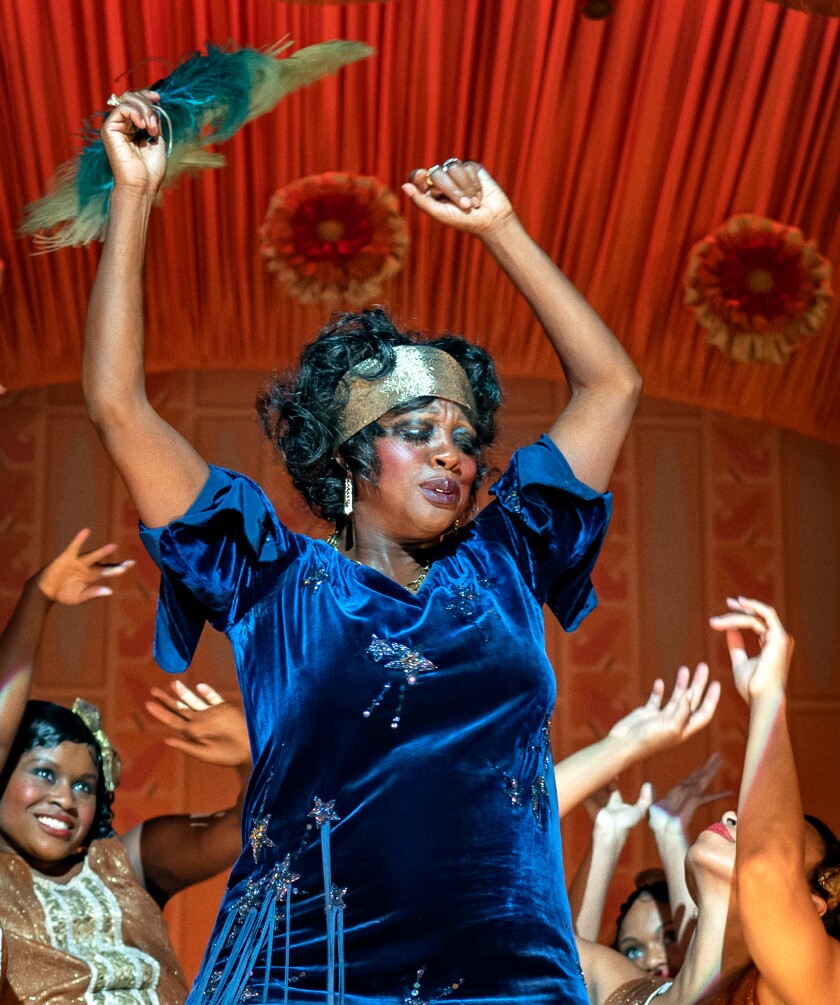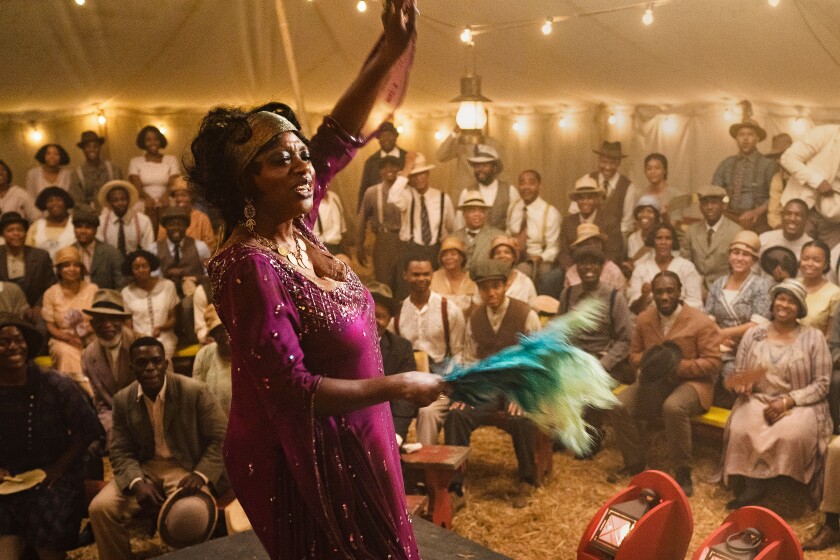Transforming Viola Davis into Ma Rainey meant staying away from ‘pretty’

Viola Davis stars in the title role of “Ma Rainey’s Black Bottom,” as the 1920s blues singer who did things her own way. (David Lee / Netflix)
Given Viola Davis’ near-perfect straight white teeth and smooth skin, it’s no small feat morphing the actress into early 20th century blues singer Ma Rainey in George C. Wolfe’s “Ma Rainey’s Black Bottom,” especially as there are only a handful of images of her in circulation.
Rainey was a true-to-herself warrior, and the wear-and-tear of that physical, emotional and spiritual daily fight to conduct her life and artistry as she pleased showed up in her image and look — heavyset and gruff, painted and proud.
To get Davis there, in an unforgiving timeline of barely more than two weeks, would seem all but impossible. Hair department head Mia Neal, who did much of the hair and wig designs, teamed with Sergio Lopez-Rivera, who handled Davis’ heavy, often streaked makeup, and Jamika Wilson (Davis’ hair) to create not just Rainey’s distinctive look but also a sense of what it meant to accomplish what she did against such a harsh environment.
Says Lopez-Rivera: “It’s clear with Ma that she tries to put up a billboard to say yes, she’s dark-skinned, heavy, not attractive, but she’s putting everything she can on her body all at once — all the jewelry and expensive fur, wigs, makeup, even in the blaring heat — she wants her status to come in the room before she comes in. I think the reason why this movie works so well is because her backstory was always on full display.”ADVERTISING
“That was [Viola’s] thing,” agrees Wilson. “She would always say she doesn’t want to see ‘pretty.’ She was on a mission in that regard,” Wilson says of Davis, who earned a lead actress Oscar nomination for the role.
The film is set in Chicago on a blistering hot afternoon in the recording studio with flashbacks to Ma Rainey belting out songs on stage.
There are so few images of Ma Rainey available. In terms of hair and makeup, is this a positive or negative thing?
Neal: It was a little difficult. I only found two photos. Our department really leans on aesthetics, so not to have that image, you must go off written descriptions. And that’s unique. But in some ways it’s helpful, because it makes me even more detailed. We knew we had to use whatever the literature said. Everyone had to be on the same page: She sweated heavily, her wig was made of horse hair, and all of these details had to be done.
Lopez-Rivera: In a way, we couldn’t be 100% true to Ma Rainey, but on the other hand, we were able to be 100% to August Wilson’s Ma Rainey. We were encouraged to fill in the blanks and tell the story.

Wilson: I remember discussions of how it was back then in the ‘20s in the South and how they toured. A lot of our creativity came from our imagining how it was for a woman like Ma back then: no air conditioning, no Black beauty products, such severe restricted movements, no hair salons you can just roll into ….
Neal: And remember, it’s also about psychology. Look at the timeline. Ma Rainey was the first generation born out of enslavement in her family. She’s born in the rural South, she is dark-skinned, which couldn’t have been easy. So think about a woman who left the South and really reinvented herself: She changed her name; she didn’t follow any of the rules — she had a husband and a girlfriend. There was no more denying her anything.
That was the tone I took when thinking about her hair, the second wig she wears during the day; it’s made of European hair. So Ma had looked in the magazines and saw white women had single waves in their hair, and her own kinky hair wouldn’t achieve that look, so she’s, “Somebody go get me a wig made out of white woman’s hair!” (Laughs)
Was this the first time you made a horse-hair wig? How was it created?
Neal: First time and the last time! (Laughs) I created the wig, but Jamika always put it on Viola. The horse hair was purchased from Europe, and it came covered in manure and dead lice eggs; obviously, they just cut it off the horse, and it was stored somewhere for a very long time. I had to literally peel it apart. It was black with random natural highlights in shades of brown and even pieces of amber. I pulled the darkest ones.
Lopez-Rivera: We’ve said this before, but we had that wig close to us in the makeup trailer, and I have to say it was a work of art. I loved that wig; it was beautiful.
Neal: And how it got onto Viola. It’s not a simple job moving into an actor’s space and taking their time and thought away and who can get in and out without a ruffle. Jamika did that with that wig.
How did you create the drippy, sweaty makeup-look consistently?

Lopez-Rivera: It was applied precisely to look messy. I used alcohol-based paints and purposefully used cream, which would melt and become a little blurry with her own skin temperature. For the sweat, I used a very old technique called stippling, where you use a large round sponge with large different-type pores, and you saturate it with a glycerin-based product.
I used a thick formula to create the beads around her forehead so they would stay put, and I’d use the thinner ones around her neck and chest so they could move or drop and it would look very natural. One of the things to help Viola become invisible from Ma was getting rid of her own eyebrows and painting on the very pencil-thin, doll-like overarched eyebrows from the period.
Wilson: Once the wig was on, and the dress was on, and the padded body suit [made by costume designer Ann Roth] was on, all of it came together perfectly. Any of those things separately wouldn’t necessarily erase Viola.
How involved was the director, George C. Wolf, in the hair and makeup?
Neal: As a hair person, directors often communicate more with the costume department, and you get your notes from them. But with George, he has a relationship with everybody on set. You can expect to have a lot of dialogue with him about the characters, the plan; he has very detailed notes. So you feel more connected to the project.
How involved was producer Denzel Washington with the hair and makeup teams?
Neal: Every day. That’s very telling of how involved he is with the project, how it’s really like his baby.
Lopez-Rivera: You could tell he was really having a good time watching George do this, letting him soar and how he was just in awe of the creative genius that is George C. Wolfe.
Wilson: I enjoyed watching Denzel watching Viola sometimes and the choices that she made. He loves Viola.
Lopez-Rivera: He thinks she’s the best thing, and she loves him right back. It’s a beautiful thing.
